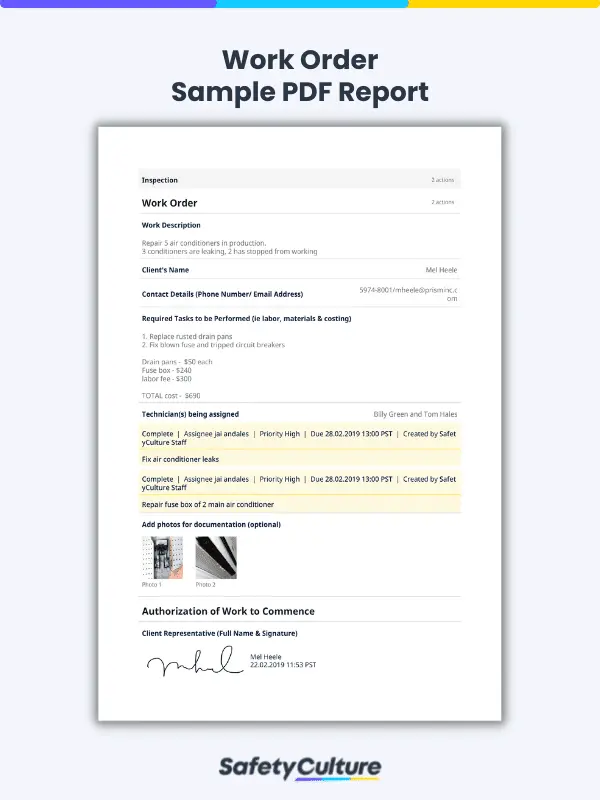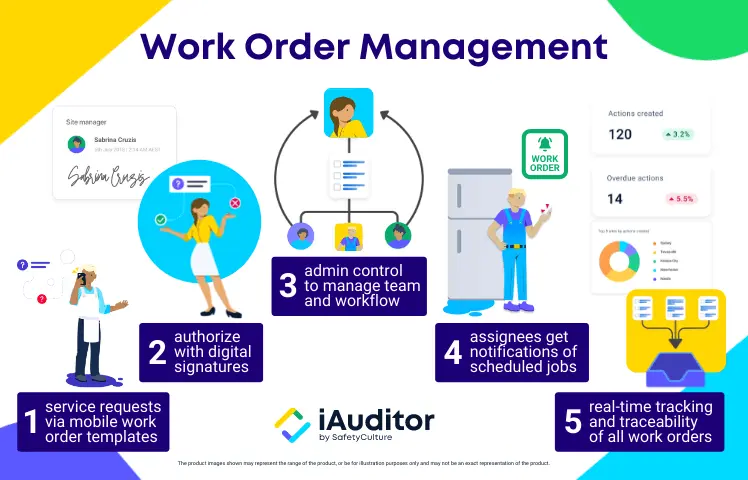What is a Work Order?
A work order is a document managers authorize for workers to complete tasks. Also known as a job order or a service order, work orders are commonly used to manage maintenance operations across industries. They can also be utilized for follow-up actions from conducted inspections or audits.
Additionally, a work order is a job or task being requested by a customer, another business entity, or internally. A common scenario for requesting a work order is when a need for preventive maintenance or repairs is identified. Work order forms assist both parties—the requestor and the person assigned—in formally documenting what the job or task entails.

Basic Work Order Example | View Sample Work Order
The Importance of Work Orders
Work orders constitute the heart of any maintenance management system. Not only are they simple tools for scheduling and assigning job tasks, but they also help monitor the variety of resources spent on maintenance. It also serves as one of the integral components of field service management with field service reports. Work orders are important because they play an essential part in standardizing maintenance workflows, particularly that of submitting work requests to closing work orders.
The Difference Between Work Order, Work Request, and Purchase Order
While a work order (WO) is sometimes called a job order or a service order in other parts of the world, they essentially mean the same thing. However, although related to one another, work orders cannot be used interchangeably with work requests and purchase orders because each term has a different meaning:
Work Order vs Work Request
The difference between a work order and a work request is their source and sequence, or where they originated and when they’re triggered. Generally, work requests come from non-maintenance personnel, leading to the creation of maintenance work orders. For example, machine operators usually submit a work request for an equipment problem first, and then maintenance managers approve a WO designated to mechanics.
Work Order vs Purchase Order
The difference between a work order and a purchase order (PO) is how they’re used in connection with maintenance work order workflows. While work orders detail specific tasks or services to be carried out, purchase orders itemize materials or products required to complete a WO. Typically, a work order includes a PO with the new parts and items to be used when repairing or servicing a piece of equipment.
Tips on How to Write a Work Order
There are several ways to create a work order, depending on company requirements and customer needs, among other factors. Whatever the case, a streamlined process for opening WOs can ensure that maintenance work will be done on time. Listed below are some general guidelines to help teams write work orders more efficiently:
Understand the work requested
Writers of job orders should not only refer to the details indicated in work requests, but they should also gain a thorough understanding of exactly what needs to be done. When in doubt or if certain information seems vague such as the equipment symptoms and initial safety considerations, they should be confirmed with the requester at the onset to prevent work duplication.
Consider the resources needed
Upon having a clear grasp of the work requested, think about the elements needed to do it. Anticipating which tools to use, stocks to check, and parts to buy can help avoid costly delays. Moreover, it is crucial to assess if the task can be performed alone, with another maintenance team member, or with colleagues from other departments like engineering and industrial design.
Be specific yet succinct
Basically, a sample work order format contains the work description, assignee(s), requester details, cost breakdown, schedule or deadline, and authorized signatures. The key to writing WOs efficiently is presenting all the necessary information in an uncomplicated manner. Reaching the balance between brevity and comprehensiveness can help minimize the risk of discrepancies during work order implementation.
Set realistic estimates and timeframes
When breaking down the cost of labor, materials, and equipment for any job, specify reasonable amounts. Asking for too little or too much might eventually hold back the processing of work orders. Apart from budget allotment, one of the biggest challenges in work order management is scheduling. Priority levels and due dates should be made in relation to technician availability, maintenance schedule, and other ongoing tasks.
Use paperless work orders
Work orders written on paper can be difficult for the management to arrange because they tend to be easily damaged and misplaced. A digital work order form, on the other hand, can be completed on any mobile device, making it easier for teams to write WOs from wherever they are. Unlike traditional paper-based service orders, digitized work orders not only minimize data input errors but also save time and effort in sending them for authorization.
Create Your Own Work Order Form
Eliminate manual tasks and streamline your operations.
Get started for FREEWork Order Sample System and Procedure
A work order system should enable employees to do maintenance tasks more efficiently, not slow them down. To streamline work order processing, first gauge the company’s performance using industry benchmarks. Compare your findings with the sample work order procedure below and identify areas of improvement for the organization’s context:
- Step 1: Work Request Submission and Review – Non-maintenance staff submit a work request which is assessed by their manager. Their managers then validate it with information captured from previous inspections before forwarding it to the maintenance department.
- Step 2: Work Order Approval and Creation – Upon receipt, the maintenance manager determines whether the scope of the work is necessary. When approved, the management records the work request as a work order with their signature.
- Step 3: Work Order Assignment and Scheduling – Following authorization, the manager assigns the task to a mechanic and schedules when it should be completed. Applying a dispatch matrix can help make sure that the most qualified technician will be sent to work on a particular asset.
- Step 4: Work Order Execution and Monitoring – At the equipment location area, the maintenance worker observes physical restraints, identifies environmental conditions, and prepares any type of notation that can aid in accomplishing the job. When resources become available, work can begin and the manager starts tracking the WO status.
- Step 5: Work Order Completion and Record-keeping – After the job is done, the maintenance technician reports the actual work performed, and their manager reviews it before closing the WO. Finally, the maintenance manager files the completed work order for future reference.
Work Order Management with SafetyCulture
For teams in any labor-intensive line of work, time is of the essence. Reduce administrative inefficiencies with the award-winning digital platform for operations management, SafetyCulture (formerly iAuditor). Here’s an overview of how you can stay on top of work order management and gain visibility across daily operations using SafetyCulture:

SafetyCulture Work Order Management Example | Start with this Basic Work Order Template




